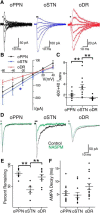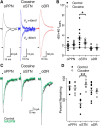Cocaine Selectively Reorganizes Excitatory Inputs to Substantia Nigra Pars Compacta Dopamine Neurons
- PMID: 29263240
- PMCID: PMC5792475
- DOI: 10.1523/JNEUROSCI.1975-17.2017
Cocaine Selectively Reorganizes Excitatory Inputs to Substantia Nigra Pars Compacta Dopamine Neurons
Abstract
Substantia nigra pars compacta (SNc) dopamine neurons and their targets are involved in addiction and cue-induced relapse. However, afferents onto SNc dopamine neurons themselves appear insensitive to drugs of abuse, such as cocaine, when afferents are collectively stimulated electrically. This contrasts with ventral tegmental area (VTA) dopamine neurons, whose glutamate afferents react robustly to cocaine. We used an optogenetic strategy to isolate identified SNc inputs and determine whether cocaine sensitivity in the mouse SNc circuit is conferred at the level of three glutamate afferents: dorsal raphé nucleus (DR), pedunculopontine nucleus (PPN), and subthalamic nucleus (STN). We found that excitatory afferents to SNc dopamine neurons are sensitive to cocaine in an afferent-specific manner. A single exposure to cocaine in vivo led to PPN-innervated synapses reducing the AMPA-to-NMDA receptor-mediated current ratio. In contrast to work in the VTA, this was due to increased NMDA receptor function with no change in AMPA receptor function. STN synapses showed a decrease in calcium-permeable AMPA receptors after cocaine, but no change in the AMPA-to-NMDA ratio. Cocaine also increased the release probability at DR-innervated and STN-innervated synapses, quantified by decreases in paired-pulse ratios. However, release probability at PPN-innervated synapses remained unaffected. By examining identified inputs, our results demonstrate a functional distribution among excitatory SNc afferent nuclei in response to cocaine, and suggest a compelling architecture for differentiation and separate parsing of inputs within the nigrostriatal system.SIGNIFICANCE STATEMENT Prior studies have established that substantia nigra pars compacta (SNc) dopamine neurons are a key node in the circuitry that drives addiction and relapse, yet cocaine apparently has no effect on electrically stimulated excitatory inputs. Our study is the first to demonstrate the functional impact of a drug of abuse on synaptic mechanisms of identified afferents to the SNc. Optogenetic dissection of inputs originating from dorsal raphé, pedunculopontine, and subthalamic nuclei were tested for synaptic modifications following in vivo cocaine exposure. Our results demonstrate that cocaine differentially induces modifications to SNc synapses depending on input origin. This presents implications for understanding dopamine processing of motivated behavior; most critically, it indicates that dopamine neurons selectively modulate signal reception processed by afferent nuclei.
Keywords: AMPA; NMDA; dorsal raphé; optogenetics; pedunculopontine nucleus; subthalamic nucleus.
Copyright © 2018 the authors 0270-6474/18/381151-09$15.00/0.
Figures






Similar articles
-
Afferent-specific AMPA receptor subunit composition and regulation of synaptic plasticity in midbrain dopamine neurons by abused drugs.J Neurosci. 2010 Jun 9;30(23):7900-9. doi: 10.1523/JNEUROSCI.1507-10.2010. J Neurosci. 2010. PMID: 20534838 Free PMC article.
-
Differential modulation by nicotine of substantia nigra versus ventral tegmental area dopamine neurons.J Neurophysiol. 2007 Dec;98(6):3388-96. doi: 10.1152/jn.00760.2007. Epub 2007 Oct 17. J Neurophysiol. 2007. PMID: 17942622
-
Cocaine Exposure Enhances the Activity of Ventral Tegmental Area Dopamine Neurons via Calcium-Impermeable NMDARs.J Neurosci. 2016 Oct 19;36(42):10759-10768. doi: 10.1523/JNEUROSCI.1703-16.2016. J Neurosci. 2016. PMID: 27798131 Free PMC article.
-
Synaptic and intrinsic plasticity in the ventral tegmental area after chronic cocaine.Curr Opin Neurobiol. 2019 Feb;54:66-72. doi: 10.1016/j.conb.2018.08.013. Epub 2018 Sep 17. Curr Opin Neurobiol. 2019. PMID: 30237117 Free PMC article. Review.
-
Differential striatal spine pathology in Parkinson's disease and cocaine addiction: a key role of dopamine?Neuroscience. 2013 Oct 22;251:2-20. doi: 10.1016/j.neuroscience.2013.07.011. Epub 2013 Jul 16. Neuroscience. 2013. PMID: 23867772 Free PMC article. Review.
Cited by
-
SynapseJ: An Automated, Synapse Identification Macro for ImageJ.Front Neural Circuits. 2021 Oct 4;15:731333. doi: 10.3389/fncir.2021.731333. eCollection 2021. Front Neural Circuits. 2021. PMID: 34675779 Free PMC article.
-
Exercise Modulates Brain Glucose Utilization Response to Acute Cocaine.J Pers Med. 2022 Nov 30;12(12):1976. doi: 10.3390/jpm12121976. J Pers Med. 2022. PMID: 36556197 Free PMC article.
-
Interfacing behavioral and neural circuit models for habit formation.J Neurosci Res. 2020 Jun;98(6):1031-1045. doi: 10.1002/jnr.24581. Epub 2020 Jan 8. J Neurosci Res. 2020. PMID: 31916623 Free PMC article. Review.
-
Protracted Abstinence From Extended Cocaine Self-Administration Is Associated With Hypodopaminergic Activity in the VTA but Not in the SNc.Int J Neuropsychopharmacol. 2021 Jul 14;24(6):499-504. doi: 10.1093/ijnp/pyaa096. Int J Neuropsychopharmacol. 2021. PMID: 33305794 Free PMC article.
-
Olfactomedin-3 Enhances Seizure Activity by Interacting With AMPA Receptors in Epilepsy Models.Front Cell Dev Biol. 2020 Aug 11;8:722. doi: 10.3389/fcell.2020.00722. eCollection 2020. Front Cell Dev Biol. 2020. PMID: 32850838 Free PMC article.
References
Publication types
MeSH terms
Substances
Grants and funding
LinkOut - more resources
Full Text Sources
Other Literature Sources
Miscellaneous
